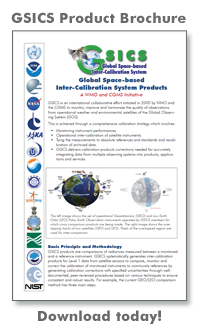GSICS Standards and Best Practices
Overview
 GSICS is a partnership comprised of several organizations that span over three continents. It is conceivable that at a given moment different
GSICS members are grabbing their morning coffee, running lunchtime errands, and putting their children to bed. But such diverse local activity
on a global basis is not unusual. On the other hand, it can be a challenge to coordinate global collaboration to perform common tasks. In GSICS,
one way that complexities associated from long-distance collaboration amongst several organizations have been tackled has been to establish technical and
organizational standards and best practices. In GSICS, these standards and best practices mainly pertain to shared satellite resources and data,
and product quality.
GSICS is a partnership comprised of several organizations that span over three continents. It is conceivable that at a given moment different
GSICS members are grabbing their morning coffee, running lunchtime errands, and putting their children to bed. But such diverse local activity
on a global basis is not unusual. On the other hand, it can be a challenge to coordinate global collaboration to perform common tasks. In GSICS,
one way that complexities associated from long-distance collaboration amongst several organizations have been tackled has been to establish technical and
organizational standards and best practices. In GSICS, these standards and best practices mainly pertain to shared satellite resources and data,
and product quality.
Satellite Resouces
Although GSICS is not responsible for procuring the operational satellite instruments that they inter-calibrate, they have adopted " Best Practice Guidelines for Pre-Launch Characterization and Calibration of Instruments for Passive Optical Remote Sensing". In this best-practice document, the currently available radiometric standards and calibration facilities at the US National Institute of Standards and Technology (NIST) are described, and examples of best practice calibrations and intercomparisons needed to build an SI-traceable uncertainty budget in the instrumentation used for preflight satellite sensor calibration and validation are presented.
Data
Data sharing within and beyond GSICS requires a great deal of coordination. Currently, GSICS has a network of Collaboration Servers at EUMETSAT and NOAA that are designed to upload, serve, and archive GSICS data. In addition, GSICS has adopted the following internationally-recognized data standards:
Product Quality
Product quality assurance is a cornerstone of GSICS success. It is important for users of GSICS data to know exactly the quality of the data they receive, so that they can properly use the data. GSICS has developed the GSICS Procedure for Product Acceptance solely for the purpose of establishing transparency of GSICS inter-calibration products.


